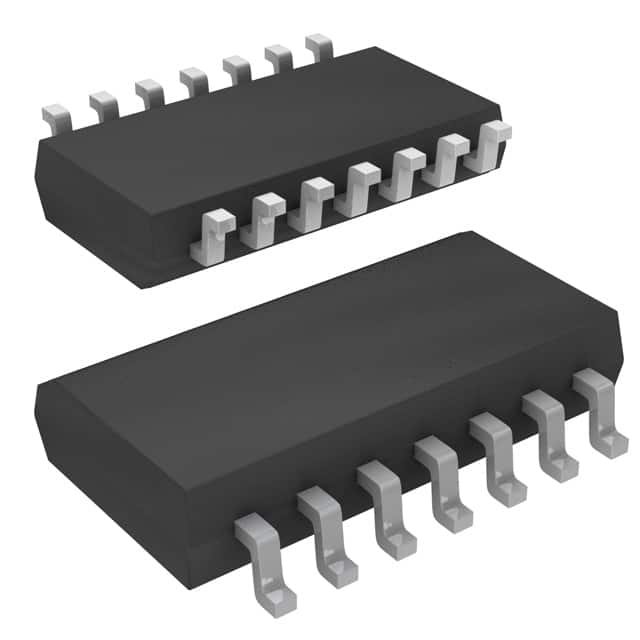Consulte las especificaciones para obtener detalles del producto.

SN74ALS243ANSR
Product Overview
- Category: Integrated Circuit
- Use: Logic Gate
- Characteristics: High-speed, TTL-compatible, Quad Bus Buffer
- Package: SOIC (Small Outline Integrated Circuit)
- Essence: Buffering and amplifying digital signals in electronic circuits
- Packaging/Quantity: Tape and Reel, 2500 units per reel
Specifications
- Logic Family: ALS
- Number of Buffers: 4
- Input Voltage: 2V to 5.5V
- Output Voltage: 2V to 5.5V
- Propagation Delay Time: 9ns
- Operating Temperature Range: -40°C to 85°C
- Supply Voltage: 4.5V to 5.5V
Detailed Pin Configuration
The SN74ALS243ANSR has a 14-pin configuration as follows:
- GND (Ground)
- A1 (Input A1)
- Y1 (Output Y1)
- A2 (Input A2)
- Y2 (Output Y2)
- A3 (Input A3)
- Y3 (Output Y3)
- A4 (Input A4)
- Y4 (Output Y4)
- VCC (Positive Power Supply)
Functional Features
- High-speed operation: The SN74ALS243ANSR is designed for high-speed applications, ensuring fast signal buffering.
- TTL compatibility: It is compatible with TTL (Transistor-Transistor Logic) voltage levels, allowing seamless integration into existing TTL-based systems.
- Quad buffer: With four independent buffers, it can handle multiple input and output signals simultaneously.
- Low power consumption: The integrated circuit is designed to consume minimal power, making it suitable for battery-powered devices.
Advantages and Disadvantages
Advantages
- High-speed operation enables efficient signal buffering.
- TTL compatibility allows easy integration into existing systems.
- Quad buffer design provides flexibility in handling multiple signals.
- Low power consumption makes it suitable for portable devices.
Disadvantages
- Limited voltage range (2V to 5.5V) may not be compatible with all applications.
- Propagation delay time of 9ns may introduce slight delays in critical timing applications.
Working Principles
The SN74ALS243ANSR operates based on the principles of digital logic. It receives digital input signals through the A1 to A4 pins and buffers them internally. The buffered signals are then available at the corresponding Y1 to Y4 output pins. The integrated circuit ensures high-speed operation by utilizing advanced semiconductor technology.
Detailed Application Field Plans
The SN74ALS243ANSR is commonly used in various electronic applications, including:
- Microprocessors: It can be employed to buffer address or data lines between the microprocessor and memory devices.
- Communication Systems: The quad buffer design allows for signal amplification and isolation in communication circuits.
- Industrial Control Systems: It finds application in controlling and buffering digital signals in industrial automation systems.
- Test and Measurement Equipment: The high-speed operation makes it suitable for use in test and measurement instruments.
Detailed and Complete Alternative Models
- SN74ALS244AN: Octal Buffer/Line Driver with 3-State Outputs
- SN74ALS245AN: Octal Bus Transceiver with 3-State Outputs
- SN74ALS240AN: Octal Inverter/Buffer with 3-State Outputs
- SN74ALS541N: Octal Buffer/Line Driver with 3-State Outputs
These alternative models offer similar functionality and characteristics to the SN74ALS243ANSR, providing options for different design requirements.
Word count: 411 words
Enumere 10 preguntas y respuestas comunes relacionadas con la aplicación de SN74ALS243ANSR en soluciones técnicas
Sure! Here are 10 common questions and answers related to the application of SN74ALS243ANSR:
Question: What is SN74ALS243ANSR?
- Answer: SN74ALS243ANSR is a specific model of integrated circuit (IC) that belongs to the ALS series of logic gates. It is commonly used in technical solutions for various applications.Question: What is the function of SN74ALS243ANSR?
- Answer: SN74ALS243ANSR is a quad bus buffer with three-state outputs. It is designed to provide buffering and signal amplification capabilities in digital circuits.Question: What voltage levels does SN74ALS243ANSR support?
- Answer: SN74ALS243ANSR supports a wide range of voltage levels, typically from 4.5V to 5.5V.Question: How many inputs and outputs does SN74ALS243ANSR have?
- Answer: SN74ALS243ANSR has four inputs and four outputs, making it suitable for applications requiring multiple signal buffering.Question: Can SN74ALS243ANSR be used in both TTL and CMOS systems?
- Answer: Yes, SN74ALS243ANSR is compatible with both TTL (Transistor-Transistor Logic) and CMOS (Complementary Metal-Oxide-Semiconductor) systems.Question: What is the maximum operating frequency of SN74ALS243ANSR?
- Answer: The maximum operating frequency of SN74ALS243ANSR is typically around 25 MHz, making it suitable for many standard digital applications.Question: Does SN74ALS243ANSR have built-in protection features?
- Answer: Yes, SN74ALS243ANSR includes built-in protection against electrostatic discharge (ESD) and excessive power dissipation.Question: Can SN74ALS243ANSR be used in high-speed data transmission applications?
- Answer: While SN74ALS243ANSR can handle moderate frequencies, it may not be suitable for very high-speed data transmission applications due to its limited operating frequency.Question: Is SN74ALS243ANSR available in different package types?
- Answer: Yes, SN74ALS243ANSR is available in various package types, including SOIC (Small Outline Integrated Circuit) and TSSOP (Thin Shrink Small Outline Package).Question: Are there any specific design considerations when using SN74ALS243ANSR?
- Answer: When designing with SN74ALS243ANSR, it is important to consider factors such as power supply decoupling, signal integrity, and proper grounding techniques to ensure reliable operation.
Please note that the answers provided here are general and may vary depending on the specific application and requirements. It is always recommended to refer to the datasheet and consult technical documentation for accurate information.

